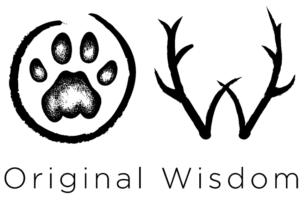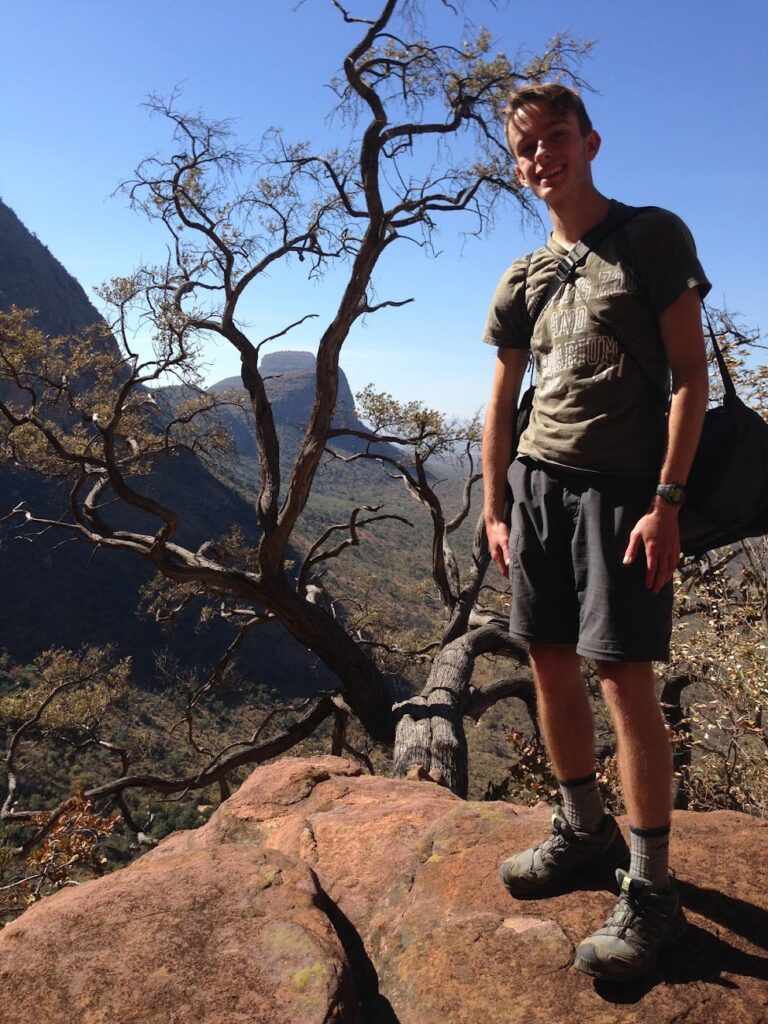All people come from cultures that tracked animals. In every family group and village across the world, it was important that men, women, and children were able to identify tracks. But they didn’t need to know every track. They focused on the ones that were important. It was important to be able to see the track of a snake or a scorpion that had entered the hut, or of a pride of lions that had silently walked by in the night and might still be nearby. It was also important to know where the francolin had laid its eggs, the larval insects were under the ground or in a tree, the favorite bedding spots of the local duikers, or the favorite feeding plants of the kudus – because these animals all provided food for our people. Not everyone would have been an excellent tracker, or even a good tracker, but everyone would have known the basics of tracking for food and safety. The excellent trackers would have been the ones who really enjoyed doing it, and chose to spend their time practicing it, usually through hunting. Everyone in a community would have had some skill that they practiced and enjoyed, whether this was flint-knapping (making stone arrowheads), forging iron, or making clothing or baskets. And just like the expert tracker would be the expert hunter over time, the basket maker would become the expert weaver over time, and everyone else in the village would have gone to him or her when they wanted to trade for a high-quality basket or woven textile. Tracking, like any other skill, just takes time and practice, which is rooted in how interested in learning you are.
Here in Hoedspruit town, just outside the Kruger National Park of South Africa, wild animals live and move all around us, going about their business. From the smallest invertebrate to the biggest giraffe or elephant, we have many of them in or near our gardens on a daily (or nightly) basis. People who know how to identify animal tracks and signs can determine who has been roaming around their driveway. Interpreting behaviours through tracks and signs takes a little more practice, for example, to be able to read in the civet’s tracks where it stopped, turned its butt towards the tree on the side of the driveway (or the house-number sign) and deposited a sticky, crystalline paste on it at about 24 cm high as some form of communication signal between itself and others of its species. Personally, we find the interpretation aspect to be much more fascinating than identification, but you can’t do one without the other.
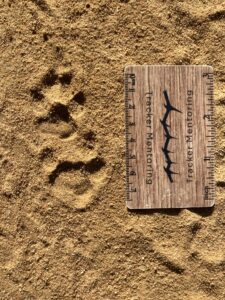
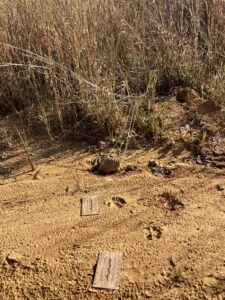
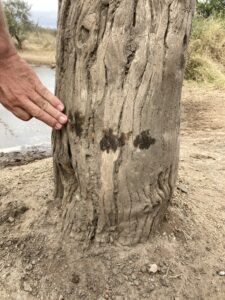
Photos from left to right: The front (bottom) and hind tracks of an African civet; the civet’s tracks deviating to the side of the sand road; a repeatedly used civet pasting.
There are very many residents of the greater Hoedspruit area who know a lot already about all of these aspects of tracking, and even about the trailing aspect, which is the following of tracks and signs to find animals – and there are probably many more residents that would have difficulty differentiating a jackal track from a housecat’s, or a leopard track from a hyena’s.
So, we thought we’d try to bring together all those types of people, anyone who is interested in learning or sharing more knowledge around the art and science of tracking, in Hoedspruit. We are offering a free morning of tracking, once a month, in the first Hoedspruit Tracking Club so that we can start to build a community around those people who are interested in learning, or teaching, more.
The first Hoedspruit Tracking Club was held on the Hoedspruit Wildlife Estate, (from 8 am until 11 am, on Saturday, the 15th of January) and hosted by one of the local businesses. Everyone was welcome and there was no prior experience necessary. And of course, it was Free! This is about building a community. The January Club, started at the African Rock Lodge, and we are happy to support the owners Sander and Juliet and their family during these difficult times (for tourism during COVID). Each monthly Club meeting will be held in a different location, with opportunities for participants to support local businesses. We hope that people will come early and buy a cup of coffee or tea before the Club sessions, or stay a little later and purchase a delicious breakfast, or just tell their friends and family members about the unique and beautiful places to stay in Hoedspruit. But, none of those are required.
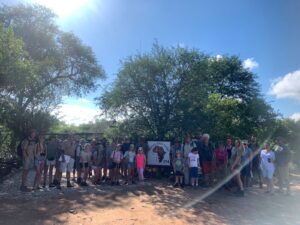
Limited spaces are available each month, so people should let us know that they intend to join us. For example, if you live outside the wildlife estate which we are visiting on a particular Club meeting, you might need to contact us for an entry/exit code. You’ll find details about each month’s meeting on our new Facebook page, the Hoedspruit Tracking Community page.
As we’ve mentioned, our vision for the tracking club is to offer it one morning a month, probably on a Saturday (but not the same Saturday as the Farmer’s Market). We will try to use different venues – if you’d like to host one and it’s within the rules of your estate, let us know. We can meet inside Hoedspruit town, on one of the nearby estates, or even at a private lodge in the greater Kruger area occasionally to try and help support local businesses. Again, you won’t be required to purchase anything, but if you can, and you want to, the options will be there.
If you don’t know who we are, then perhaps introductions are necessary… We are both Senior Trackers and Assessors of Trackers on the CyberTracker system, which is the gold-standard for assessing wildlife trackers across the world. Lee has lived in Hoedspruit since 2012, and Kersey joined him in 2015.
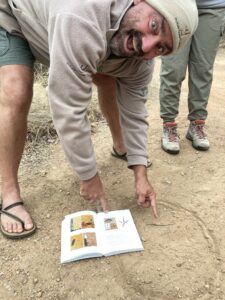
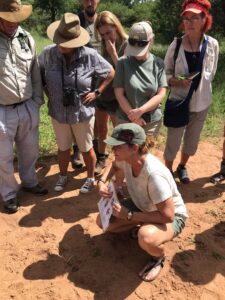
Lee teaching bird tracks and signs with one of his published books, and Kersey teaching the difference between civet and jackal tracks with Louis Liebenberg’s fantastic drawings.
Lee is a FGASA Scout guide, the highest qualification that can be achieved in Southern Africa for guiding, and has trained guides for over 30 years through his reputable company, Nature Guide Training. You might also have seen some of his nine different books on the shelves in local shops like MJ’s Photographic in the Kamogelo Center, or The Great Outdoors in the Pick N Pay centre, or even in Kruger Park shops and Exclusive Books shops (If you already have one of these books and would like Lee to sign it during the Club meeting, bring it!). Kersey is an award-winning university lecturer from the USA, the first woman in the world to earn the Senior Tracker certification, and has a doctorate in the ecology and culture of tracking. She has authored several peer-reviewed scientific publications and co-authored with Lee the Tracker Mentoring Manual, an instructional guide to teach the process of tracking. We are both passionate about nature and teaching. So, we have some experience. This is not to say that we want to monopolize the Club though, because there will be times when we aren’t available to lead the club, and we know of many other fantastic trackers in our lovely home area that would be willing to step in with high-quality instruction and a different teaching perspective.
There are places where we go in Europe and North America to train and assess trackers that only have the smallest species of deer still present (or only non-native species), the magnificent stags and predators are gone from the landscape, and people will be arrested or fined if they go off the pathways. We are fortunate here in South Africa to still have places where ecosystems are still large and contain most of the original suite of species. But even if you live in an area where there are only genets, domestic housecats, doves, and starlings, you can learn something about those species, and learning something will help you build a foundation about “how to learn” tracking, which will also make you more informed about the ecology of your place. Don’t be intimidated if you don’t know much because you don’t have to! This is about building a community of interested and interesting people – The Hoedspruit Tracking Community!
If you like this, please share it, and tag us at #trackingisoriginalwisdom, #trackermentoring, #natureguidetraining, #cybertracker , and #trackercertification
Download Original Wisdom’s recommended reading list for trackers by signing up for our newsletter! Once the sign-up form has been submitted, you will be re-directed to the download page. Our recommended reading list is specific to Southern Africa and North America, but, a good tracking book is helpful in any region as a starting point to learn how to look at track morphology and animal behavior. [contact-form-7 id=”2892″ title=”Subscribe to the newsletter”]
Interested in online and correspondence tracking courses? Visit us at TrackerMentoring.com.
Check out our calendar at OriginalWisdom.com for our in-person tracking courses and CyberTracker evaluations/assessments in Africa or North America (trailing and track & sign identification). We also run ecological and cultural education programs in Africa for academic institutions.
Become a qualified guide in South Africa through our 60-day, entirely in-the-field, FGASA Apprentice Guide program. Led by renowned trainer, guide, and author Lee Gutteridge. Find out more at NatureGuideTraining.com or email lee@natureguidetraining.com.
